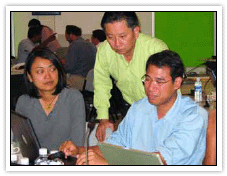Going with the flows
Sustainable development in the Mekong River Basin calls for finding the right balance between economic and social benefits and environmental and social impacts. If these decisions are to be careful and informed they need a wide range of data and this is where the integrated basin flow management (IBFM) work being undertaken jointly by a team from the Water Utilisation Programme (WUP) and the Environment Programme (EP) is being implemented.

The MRC’S IBFM activities are designed to provide information to the member states of the predicted costs and benefits of land and water development of the basin. This information is to aid discussions between the countries on the trade-offs that may be necessary between basin development and social and environmental impacts and allow them to agree on a mutually acceptable framework for sustainable development. It will also allow for reasonable and equitable transboundary sharing of benefits and serve as a basis for stakeholder dialogues, identifying valuable assets and acceptable levels of change in relation to benefits from water resources development.
These IBFM activities encompass three phases over the period of 2004-2008. Phase 1, already completed, was a one-year hydrological assessment of the Lower Mekong Basin. An important outcome of this work was a review and synthesis of the available data and information and the subsequent publication of the Overview of the Hydrology of the Mekong Basin (MRCS 2005). This aim of this report is to inform a wide readership about essential hydrometeorological features of the Mekong Basin and the modelling capacity in the MRCS.
During 2005 the MRC completed its first basinwide flow assessments based on evaluation of the environmental, social and economic beneficial uses of water under possible future flow regimes representing a range of possible basin development activities. This approach has not been used in the Mekong Basin before and the results form part of the WUP's holistic approach to basin planning in Phase 2 of its IBFM activities.
The purpose of environmental flows (according to an IUCN definition) is to provide a flow regime that is adequate to ensure downstream environmental, social and economic benefits. The appropriate environmental flow for a particular river will depend on the values placed on different economic and social requirements. Those values will determine decisions about how to balance environmental, economic and social aspirations and the uses of the river's waters.
WUP and the EP gathered a 19-strong multidisciplinary team during 2005 for a pilot study of how the MRC's flow assessment work should be undertaken. The team consisted of specialists in hydrology, hydraulics and hydrodynamic modelling, water quality, botany, geomorphology/sedimentology, aquatic invertebrates, fisheries, herpetology, ornithology, sociology and economics.
Their joint activities produced three streams of information, each providing important insights in its own right, as well as being part of a comprehensive picture of possible change:
- A biophysical assessment of how the river and its resources could change as a result of development-driven changes in flow.
- An economic assessment which presented a first approximation of the value of all the present attibutes and beneficial uses of the river system and how these could change with a changing river.
- A social assessment of how the changing river could have an impact, both positively and negatively, on people people living near the river and in the Basin.

The study concluded that:
- Much of the of the Mekong system is in relatively good condition, but, locally, some ecosystem components have been severely degraded.
- There is substantial room for further water-resource development without severe ecological degradation of the river ecosystem.
- It is likely that the future development interests of the member-States can be managed and/or mitigated with good up-front planning, good project design and operation and a good spirit of cooperation.
- The findings provide details upon which discussion can begin, both within countries and between countries on possible trade-offs between development and resource protection.
- On a macro scale, much of the social impact associated with increased development of water and related resources in the Basin will be positive.
- There are some important areas of concern requiring further study, including the vulnerability of the Tonle Sap and the Cambodian floodplain to possible flow changes and the maintenance of deep pool habitats for fisheries below Khone Falls in Lao PDR.
The work also constitutes part of the Mekong Wetland Biodiversity Conservation and Sustainable Use project (a joint programme with IUCN, UNDP and MRC). It has also provided an enabling framework for sustainable development through which member countries can agree on procedures regarding maintenance of flows on the mainstream.
In April 2006, the EP will commence a four-year research programme, building on the experience gained in IBFM Phases 1 and 2.
Under this study, which combines hydrological analysis with detailed multidisciplinary research of various aspects of river and flood plain ecology, a team of international and riparian specialists will collect flow-related information at several sites within the basin. Information on geomorphology, hydrodynamics, water quality, fish, invertebrates, vegetation, birds and human uses of riverine resources are among the disciplines to be incorporated into the study.
At the end of each year findings will be summarised at a Review Workshop and the predictions of change that came from Phase 2 will be reviewed and revised if necessary. The findings from these workshops can be used progressively by the MRC and the four national governments in their decision making processes. At the same time use of international mentors will increase technical capacity within the countries.
Choose a newsletter: